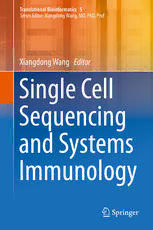
Single Cell Sequencing and Systems Immunology PDF
Preview Single Cell Sequencing and Systems Immunology
Translational Bioinformatics 5 Series Editor: Xiangdong Wang, MD, PhD, Prof Xiangdong Wang Editor Single Cell Sequencing and Systems Immunology Translational Bioinformatics Volume 5 Serieseditor XiangdongWang,MD,Ph.D. Professor of Medicine, Zhongshan Hospital, Fudan University Medical School, China DirectorofShanghaiInstituteofClinicalBioinformatics,(www.fuccb.org) ProfessorofClinicalBioinformatics,LundUniversity,Sweden AimsandScope The Book Series in Translational Bioinformatics is a powerful and integrative resource for understanding and translating discoveries and advances of genomic, transcriptomic, proteomic andbioinformatic technologies intothestudy ofhuman diseases. TheSeries represents leading global opinions on the translation of bioinformatics sciences into both the clinical setting and descriptions to medical informatics. It presents the critical evidence to further understand the molecular mechanisms underlying organ or cell dysfunctions in human diseases, the results of genomic,transcriptomic,proteomicandbioinformaticstudiesfromhumantissuesdedicatedtothe discovery andvalidationof diagnosticand prognostic disease biomarkers, essential information ontheidentificationandvalidationofnoveldrugtargetsandtheapplicationoftissuegenomics, transcriptomics,proteomicsandbioinformaticsindrugefficacyandtoxicityinclinicalresearch. The Book Series in Translational Bioinformatics focuses on outstanding articles/chapters presenting significant recent works in genomic, transcriptomic, proteomic and bioinformatic profiles related to human organ or cell dysfunctions and clinical findings. The Series includes bioinformatics-driven molecular and cellular disease mechanisms, the understanding of human diseasesandtheimprovementofpatientprognoses.Additionally,itprovidespracticalanduseful studyinsightsintoandprotocolsofdesignandmethodology. SeriesDescription Translational bioinformatics is defined as the development of storage-related, analytic, and interpretivemethodstooptimizethetransformationofincreasinglyvoluminousbiomedicaldata, and genomic data in particular, into proactive, predictive, preventive, and participatory health. Translational bioinformatics includes research on the development of novel techniques for the integrationofbiologicalandclinicaldataandtheevolutionofclinicalinformaticsmethodologyto encompassbiologicalobservations. Theendproductoftranslationalbioinformaticsisthenewly foundknowledgefromtheseintegrativeeffortsthatcanbedisseminatedtoavarietyofstakeholders includingbiomedical scientists,clinicians,andpatients.Issues relatedtodatabase management, administration, or policy will be coordinated through the clinical research informatics domain. Analytic,storage-related, andinterpretivemethodsshouldbeusedtoimprovepredictions, early diagnostics,severitymonitoring,therapeuticeffects,andtheprognosisofhumandiseases. RecentlyPublishedandForthcomingVolumes AppliedComputationalGenomics PediatricBiomedicalInformatics Editor:YinYaoShugart Editor:JohnHutton Volume1 Volume2 BioinformaticsofHumanProteomics BioinformaticsforDiagnosis,Prognosis Editor:XiangdongWang andTreatmentofComplexDiseases Volume3 Editor:BairongShen Volume4 Moreinformationaboutthisseriesathttp://www.springer.com/series/11057 Xiangdong Wang Editor Single Cell Sequencing and Systems Immunology Honor editors Xiaoming Chen Zhihong Sun Jinglin Xia 123 Editor XiangdongWang ZhongshanHospital FudanUniversity China ShanghaiInstituteofClinicalBioinformatics China ISSN2213-2775 ISSN2213-2783 (electronic) TranslationalBioinformatics ISBN978-94-017-9752-8 ISBN978-94-017-9753-5 (eBook) DOI10.1007/978-94-017-9753-5 LibraryofCongressControlNumber:2015936190 SpringerDordrechtHeidelbergNewYorkLondon ©SpringerScience+BusinessMediaDordrecht2015 Thisworkissubjecttocopyright.AllrightsarereservedbythePublisher,whetherthewholeorpartof thematerialisconcerned,specificallytherightsoftranslation,reprinting,reuseofillustrations,recitation, broadcasting,reproductiononmicrofilmsorinanyotherphysicalway,andtransmissionorinformation storageandretrieval,electronicadaptation,computersoftware,orbysimilarordissimilarmethodology nowknownorhereafterdeveloped. Theuseofgeneraldescriptivenames,registerednames,trademarks,servicemarks,etc.inthispublication doesnotimply,evenintheabsenceofaspecificstatement,thatsuchnamesareexemptfromtherelevant protectivelawsandregulationsandthereforefreeforgeneraluse. Thepublisher,theauthorsandtheeditorsaresafetoassumethattheadviceandinformationinthisbook arebelievedtobetrueandaccurateatthedateofpublication.Neitherthepublishernortheauthorsor theeditorsgiveawarranty,expressorimplied,withrespecttothematerialcontainedhereinorforany errorsoromissionsthatmayhavebeenmade. Printedonacid-freepaper SpringerScience+Business MediaB.V.DordrechtispartofSpringerScience+Business Media(www. springer.com) Preface TheVolumeofSingleCellSequencingandSystemsImmunologyhastakenmore than a year to prepare and write, due to the rapid development of science and discovery.Thisparticularvolumebringsaspecialattentiononpracticalapplication of single cellsequencingandsystems immunologyforclinicalresearch or human materials-basedstudies.Ithasbeenatruelabourofprotocoldevelopment,includ- ing methodological design and collection, practical repeatability, and handling experience. It has been a hard time of concept definition and clarification of systems immunology. We hope that the readers can find the link between single cell sequencing and systems immunology, apply single cell sequencing for the understandingofsystemsimmunology,andintegratebothtodiscovernewdisease- specific biomarkers and therapeutic targets. The most important feature of the Volume is to emphasize the potential of single cell biology and function in the pathogenesis of diseases. It is a time to explore alterations of human single cell biological function, epigenetics, metabolisms, or gene/protein networks and interactions.The Volumeis particularlysuitable forbiomedicalstudents, practical junior researchers, and principle investigators who are working and planning to perform studies on single cell sequencing and systems immunology. One of the greatestjoysincreatingthisVolumehasbeenworkingwithalloutstandingexperts, especiallythoseyoungresearchersandscientistswhogavethisprojectnotjusttheir timeandeffort,buttheirheartsandsouls.Theirseriousnessandhardworkdeserved thehighestrespectandcongratulation.Idonotbelievewecancreatesuchexciting andstimulatingVolumewithouttheirdedicationandcontributions. China XiangdongWang v Contents 1 SignificanceofSingleCellSequencinginFutureMedicine............ 1 MengjiaQian, DuojiaoWu, DingZhang, JianWang, YunfengCheng,andXiangdongWang 2 UncoveringPhenotypeswithSupercells: Applications toSingle-CellSequencing.................................................. 11 JuliánCandia,JayanthR.Banavar,andWolfgangLosert 3 Single-CellSequencingofMicroorganisms.............................. 31 YingChenandFengpingWang 4 TheApplicationofSingle-CellSequencinginDynamic Transcriptomes ............................................................. 41 KenianChen,XiaominDong,andJiaqianWu 5 SystemImmunologyinMetabolicResearchofDendriticCells....... 65 DuojiaoWu 6 FOXP3+ TregCellsandSystemsBiologyApproaches toStudyingTheirFunction................................................ 73 XueruiLuo,AndyTsun,JingYang,ZuojiaChen,YayiGao, KongchenLi,MirandaPiccioni,andBinLi 7 ”•TCellsand’“TCells................................................... 95 LingyanWang,FupingWang,JieyiShi,andXiangdongWang 8 Prolymphocyte:LymphocytesandBioinformatics ..................... 111 MengjiaQian,ClaudioSpada,andXiangdongWang 9 LymphocytesinLiverCancer............................................. 123 XiaojingXu,WilliamC.S.Cho,andJinglinXia 10 EarlyBiomarkersofHepatocyteNecrosis............................... 143 MitchellR.McGillandHartmutJaeschke vii viii Contents 11 ProtocolforSingleCellIsolationbyFlowCytometry.................. 155 JianWang,ZhihuiMin,MeilingJin,andXiangdongWang 12 A Simple Protocol for Single Lung Cancer Cell Isolation-Makingthe Single CellBasedLung Cancer ResearchFeasibleforIndividualInvestigator........................... 165 DingZhangandXiangdongWang 13 CancerBioinformatics..................................................... 175 MingyanHe,LiFeng,andJinglinXia About the Editors Xiangdong Wang, M.D., Ph.D., is a Distinguished Professor of Respiratory Medicine at Fudan Univer- sity, Director of Fudan University Center of Clinical Bioinformatics, Deputy Director of Shanghai Respira- tory Research Institute, Adjunct Professor of Clinical Bioinformatics at Lund University, and Visiting Pro- fessor of King’s College of London. He serves as a DirectorofBiomedicalResearchCenter,FudanUniver- sity,ZhongshanHospital.Hismainresearchisfocused on clinical bioinformatics, disease-specific biomark- ers, cancer immunology, and molecular and cellular therapies. Hisgroupintegratesclinicalinformaticswithomicsscienceandbioinformatics to identify and validate disease-specific biomarkers and therapeutic targets in chronic lung diseases and lung cancer. His group initially developed the mirror- butterfly chemical structure of phosphoinositide 3-kinase inhibitor to prevent and treat chronic lung inflammation and injury, in combination of his pharmaceutical experienceofdrugdiscoveryanddevelopment. In addition, Dr Wang serves as the Executive Vice President of International SocietyforTranslationalMedicine,ChairmanofExecutiveCommitteeofInterna- tional Society for Translational Medicine, Deputy President of Chinese National ProfessionalSocietyofInsurance&HealthandaSeniorAdvisorofChineseMedi- calDoctorAssociation,andDirectorofNationalProgramofDoctor-Pharmaceutist Communication.DrWangwasappointedasthePrincipalScientist,GlobalDisease Advisor, Medical Monitor and Director, and Chairman of Director Board in a number of pharmaceutical companies, e.g., Astra Draco, AstraZeneca, PPT, and CatheWill. He worked on pharmacology profiles of target identification and validation,drugscreeningandoptimization,drugPKandPDprofile,andtranslation between discovery and development in areas of respiratory diseases, inflamma- tion, and cancer. He acted as the Adjunct Professor of Molecular Bioscience at ix
